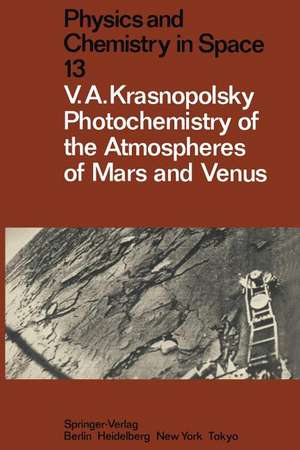Photochemistry of the Atmospheres of Mars and Venus: Physics and Chemistry in Space, cartea 13
Autor Vladimir A. Krasnopolsky Editat de U. V. Zahnen Limba Engleză Paperback – 6 dec 2011
Din seria Physics and Chemistry in Space
-
 Preț: 385.84 lei
Preț: 385.84 lei -
 Preț: 382.18 lei
Preț: 382.18 lei - 15%
 Preț: 643.84 lei
Preț: 643.84 lei -
 Preț: 383.50 lei
Preț: 383.50 lei - 18%
 Preț: 729.84 lei
Preț: 729.84 lei - 15%
 Preț: 637.59 lei
Preț: 637.59 lei -
 Preț: 385.08 lei
Preț: 385.08 lei -
 Preț: 381.98 lei
Preț: 381.98 lei -
 Preț: 381.43 lei
Preț: 381.43 lei - 15%
 Preț: 637.78 lei
Preț: 637.78 lei - 15%
 Preț: 634.49 lei
Preț: 634.49 lei -
 Preț: 388.34 lei
Preț: 388.34 lei -
 Preț: 392.21 lei
Preț: 392.21 lei - 15%
 Preț: 697.47 lei
Preț: 697.47 lei -
 Preț: 382.18 lei
Preț: 382.18 lei - 15%
 Preț: 643.84 lei
Preț: 643.84 lei - 15%
 Preț: 638.43 lei
Preț: 638.43 lei -
 Preț: 383.50 lei
Preț: 383.50 lei -
 Preț: 385.08 lei
Preț: 385.08 lei -
 Preț: 385.08 lei
Preț: 385.08 lei - 18%
 Preț: 778.32 lei
Preț: 778.32 lei - 18%
 Preț: 777.83 lei
Preț: 777.83 lei -
 Preț: 381.81 lei
Preț: 381.81 lei
Preț: 642.83 lei
Preț vechi: 756.27 lei
-15% Nou
Puncte Express: 964
Preț estimativ în valută:
123.01€ • 128.69$ • 102.18£
123.01€ • 128.69$ • 102.18£
Carte tipărită la comandă
Livrare economică 03-17 aprilie
Preluare comenzi: 021 569.72.76
Specificații
ISBN-13: 9783642704031
ISBN-10: 3642704034
Pagini: 348
Ilustrații: X, 334 p.
Dimensiuni: 155 x 235 x 18 mm
Greutate: 0.49 kg
Ediția:Softcover reprint of the original 1st ed. 1986
Editura: Springer Berlin, Heidelberg
Colecția Springer
Seria Physics and Chemistry in Space
Locul publicării:Berlin, Heidelberg, Germany
ISBN-10: 3642704034
Pagini: 348
Ilustrații: X, 334 p.
Dimensiuni: 155 x 235 x 18 mm
Greutate: 0.49 kg
Ediția:Softcover reprint of the original 1st ed. 1986
Editura: Springer Berlin, Heidelberg
Colecția Springer
Seria Physics and Chemistry in Space
Locul publicării:Berlin, Heidelberg, Germany
Public țintă
ResearchCuprins
1 Chemical Composition and Structure of the Martian Atmosphere.- 1.1 Carbon Dioxide and Atmospheric Pressure.- 1.2 CO and O2 Mixing Ratios.- 1.3 Ozone.- 1.4 Water Vapor.- 1.5 Composition of the Upper Atmosphere as Determined from Airglow Spectroscopy.- 1.6 Mass Spectrometric Measurements of the Atmospheric Composition.- 1.7 Ionospheric Composition.- 1.8 Temperature Profile of the Lower Atmosphere.- 1.9 Temperature of the Upper Atmosphere.- 1.10 Eddy Diffusion Coefficient.- 2 Photochemistry of the Martian Atmosphere.- 2.1 Ionosphere.- 2.2 Photochemistry of Nitrogen.- 2.3 H2 Dissociation and Escape of Atomic Hydrogen.- 2.4 Nonthermal Escape and Isotopic Composition of Oxygen and Nitrogen.- 2.5 Dissociation of C02: Atomic Carbon in the Upper Atmosphere.- 2.6 Diffusion and Photolysis of Water Vapor.- 2.7 Photochemistry of the Lower Atmosphere (Global Average Conditions).- 2.8 Diurnal Variations of Minor Components in the Low Latitude Atmosphere.- 2.9 Latitudinal Distribution of Ozone in Different Seasons.- 2.10 Seasonal Variations of Atmospheric Composition at a Latitude of 65 °N.- 3 Chemical Composition and Structure of the Yenusian Atmosphere and Cloud Layer.- 3.1 Properties of Aerosol in the Upper Part of the Cloud Layer Deduced from Polarization Measurements.- 3.2 Interpretation of Spectroscopic Measurements of Escaping Radiation.- 3.3 Spectroscopy in Visible and Infrared Ranges.- 3.4 Remote Sounding of Water Vapor and Carbon Monoxide in Far Infrared and Microwave Regions. Radio Spectrum.- 3.5 Optical Measurements in the 0.45–1.2 ?m Range from Venera Landers.- 3.6 Mass Spectrometric and Gas Chromatographic Measurements in the Lower Atmosphere.- 3.7 Physical Characteristics of the Cloud Layer.- 3.8 Ultraviolet Absorption in the Cloud Layer.- 3.9 Investigation of aCloud Layer Elemental Composition by X-Ray Fluorescent Spectroscopy in the Region of 1 to 20 Å (0.6–13 keV).- 3.10 Summary of the Data on the Tropospheric and Cloud Layer Composition.- 3.11 The Upper Atmosphere.- 3.12 Ionosphere.- 3.13 Temperature, Eddy Mixing, Atmospheric Dynamics, and Lightning.- 4 Photochemistry of the Venusian Atmosphere.- 4.1 Day Side Ionosphere.- 4.2 Nighttime Ionosphere.- 4.3 Metastable Species in the Venusian Ionosphere. Nitric Oxide, Atomic Nitrogen, and Atomic Carbon.- 4.4 Light Components of the Upper Atmosphere (H, H2, He). “Hot” Atoms and Nonthermal Escape of H, He, and O.- 4.5 Thermospheric Models.- 4.6 Lightning and Lower Atmospheric Chemistry. Nitric Oxide in the Lower Atmosphere.- 4.7 Lower Atmospheric and Surface Rock Compositions (0 – 50 km).- 4.8 Neutral Atmospheric Photochemistry Above 50 km. Main Problems, Previous Results, Main Chemical Reactions.- 4.9 Radiative Transfer and Aerosol Transport in the Cloud Laye.- 4.10 Boundary Conditions.- 4.11 Atmospheric Composition at 50 to 200 km (Results of Calculations).- 4.12 O2 1.27 µm and O (1D) 630 nm Airglow. Photolytic Rates.- 4.13 The Influence of Some Reaction Rate Coefficients on the Results of Calculations.- 4.14 Photochemistry of the Venusian Mesosphere as Considered by Winick and Stewart (1980).- 4.15 Analysis of Atmospheric Photochemistry on Venus by Yung and DeMore (1982).- 4.16 Loss of Water from Venus and Its Atmospheric Evolution.- 4.17 Conclusions.- References.










